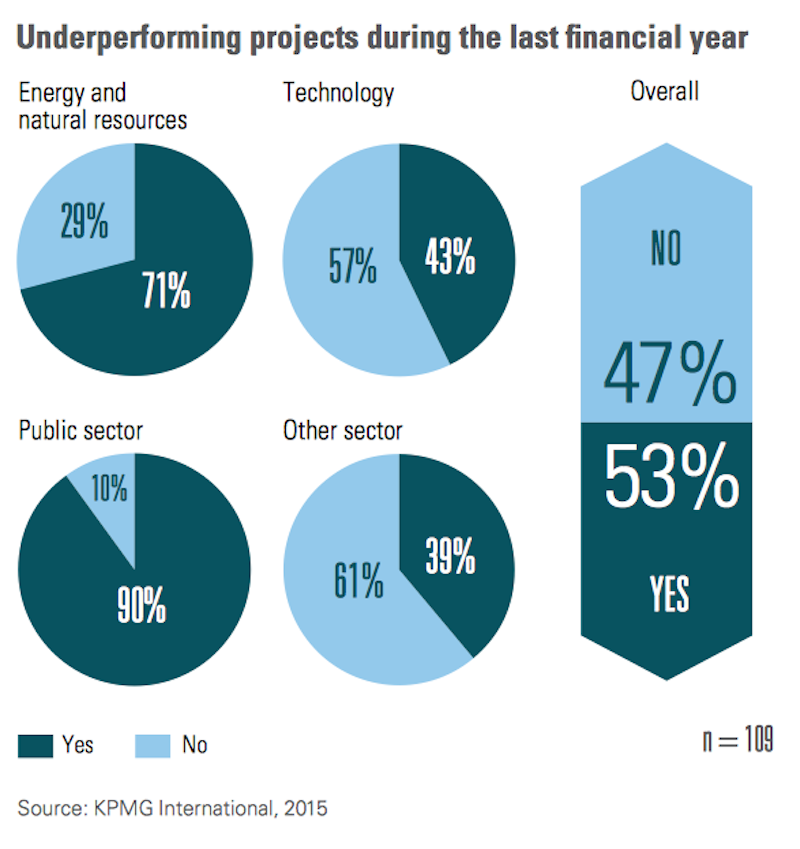Despite their planning and risk management efforts, owners are still finding that a sizable percentage of their projects are either failing or aren’t coming in anywhere near on time or on budget.
More than half—53%—of owners say they suffered one or more underperforming projects in the previous year, a number that rises to 61% for larger organizations, according to KPMG International’s ninth annual Global Construction Survey 2015, based on interviews with 109 senior leaders from private and public organizations around the world that conduct construction activity.
Only 31% of respondents’ projects over the past three years came in within 10% of their budgeted cost. And only one quarter of projects over that period came in within 10% of their original deadlines.
The owners imply that these failures, delays, and overruns are less the result of poor project oversight than of talent shortages and the lack of integration of project management information systems into these companies’ accounting and procurement software programs.

Most owners polled assert that their companies use formal screening, prioritizing, and approval processes for projects, including financial and risk analysis (84%). More than 80% of respondents state that the majority of their capital projects are planned. Thirty percent of respondents use a design-bid-build project delivery strategy, while 32% use engineer-procure-construct.
“All potential projects should be systematically identified, classified, screened, prioritized, evaluated and selected,” writes Jeff Shaw, Director-KPMG in South Africa. “This process must be supported by an appropriate budget allocation and monitoring process. Throughout the capital allocation process, alignment between strategic objectives and the capital project portfolio must be tested.”
The report notes, however, that owners are challenged finding qualified project management personnel. Forty-five percent of respondents say they struggle to attract qualified craft labor, planners and project management professionals.
While 64% of respondents believe their management controls are either “optimized” or “monitored,” nearly one-third concede that their controls are “standardized,” with no testing or reporting or reporting to management and only limited staff training.
Most construction companies rely heavily on software to manage projects. Fifty-five percent of respondents say they are “satisfied” or “mostly satisfied” about the return on investment from project management tools and training. And 73% say they are confident about the accuracy and timeliness of reports they receive from managers and contractors.
However, only about half of respondents say their organizations have introduced an integrated project management information system (PMIS). Consequently, less than one-fifth of respondents could answer “yes” definitively when asked if investments in project governance and controls have reduced project costs.
In planning for delays and cost overruns, senior executives polled identify a range of methods to calculate contingency levels. The two most popular are setting aside an specific amount of contingency for all projects (e.g., 10%), and quantitative risk analysis. “The relative sophistication of the latter suggests that owners are trying to become more accurate in their forecasting,” the report states.
Sixty-nine percent of owners polled say that “poor contractor performance” is one of the biggest reasons for failing projects, delays, or cost overruns. And there’s definitely something negative going when only one-third could say they have a “high” level of trust with pros.
More than eight in 10 respondents expect greater collaboration with contractors over the next five years. How much these relationships actually change, though, remains to be seen. The report suggests that lump-sum, fixed-price contracts, which dominate among the survey’s respondents, are one reason for the fragile state of owner-contractor relationships, primarily because they defer risk onto the contractor. And owners believe the balance of power is shifting toward them; nearly half expect to have more negotiating strength when delivering capital projects over the next five years.
KPMG International offers five steps for owners to improve the performance of their projects:
- Take a fresh approach to talent management through more effective recruitment, development, and retention strategies;
- Execute a fully integrated PMIS for swift coordination and real-time reporting;
- Demand practical targets from contractors based on realistic expectations of what can go wrong;
- Use contingency planning to control costs rather than excuse overruns; and
- Invest in relationships with contractors by creating integrated project teams.

Related Stories
| Feb 23, 2011
London 2012: What Olympic Park looks like today
London 2012 released a series of aerial images that show progress at Olympic Park, including a completed roof on the stadium (where seats are already installed), tile work at the aquatic centre, and structural work complete on more than a quarter of residential projects at Olympic Village.
| Feb 23, 2011
Call for Entries: 2011 Building Team Awards, Deadline: March 25, 2011
The 14th Annual Building Team Awards recognizes newly built projects that exhibit architectural and construction excellence—and best exemplify the collaboration of the Building Team, including the owner, architect, engineer, and contractor.
| Feb 23, 2011
Green building on the chopping block in House spending measure
Bryan Howard, Legislative Director of the U.S. Green Building Council, blogs about proposed GOP budget cuts that could impact green building in the commercial sector.
| Feb 22, 2011
LEED Volume Program celebrates its 500th certified Pilot Project
More than 500 building projects have certified through the LEED Volume Program since the pilot launched in 2006, according to the U.S. Green Building Council. The LEED Volume Program streamlines the certification process for high-volume property owners and managers, from commercial real estate firms, national retailers and hospitality providers, to local, state and federal governments.
| Feb 15, 2011
New 2030 Challenge to include carbon footprint of building materials and products
Architecture 2030 has just broadened the scope of its 2030 Challenge, issuing an additional challenge regarding the climate impact of building products. The 2030 Challenge for Products aims to reduce the embodied carbon (meaning the carbon emissions equivalent) of building products 50% by 2030.
| Feb 15, 2011
New Urbanist Andrés Duany: We need a LEED Brown rating
Andrés Duany advocates a "LEED Brown" rating that would give contractors credit for using traditional but low cost measures that are not easy to quantify or certify. He described these steps as "the original green," and "what we did when we didn't have money." Ostensibly, LEED Brown would be in addition to the current Silver, Gold and Platinum ratings.
| Feb 14, 2011
Sustainable Roofing: A Whole-Building Approach
According to sustainability experts, the first step toward designing an energy-efficient roofing system is to see roof materials and systems as an integral component of the enclosure and the building as a whole. Earn 1.0 AIA/CES learning units by studying this article and successfully completing the online exam.
| Feb 11, 2011
Four Products That Stand Up to Hurricanes
What do a panelized wall system, a newly developed roof hatch, spray polyurethane foam, and a custom-made curtain wall have in common? They’ve been extensively researched and tested for their ability to take abuse from the likes of Hurricane Katrina.













